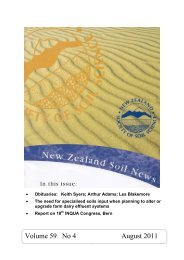Download - New Zealand Society of Soil Science
Download - New Zealand Society of Soil Science
Download - New Zealand Society of Soil Science
You also want an ePaper? Increase the reach of your titles
YUMPU automatically turns print PDFs into web optimized ePapers that Google loves.
soil and ground water quality and livestock health. The rate <strong>of</strong> F accumulation in topsoils depends on<br />
soil texture, type <strong>of</strong> minerals, and pH. In most pastoral soils with near-neutral pH, the majority <strong>of</strong><br />
fertiliser-derived F remains in the topsoil and little moves below a depth <strong>of</strong> 20-30 cm and therefore is<br />
unlikely to contaminate ground waters. However, F may pose a risk to shallow ground waters in very<br />
acidic low P-fixing soils.<br />
Pasture forage accumulation <strong>of</strong> F is very low; therefore, F intake by animals through pasture<br />
consumption is much lower than F intake through soil ingestion. Ingestion <strong>of</strong> high rates <strong>of</strong> topsoil<br />
having elevated F concentrations can result in chronic fluorosis leading to bone damage or tooth wear<br />
in livestock.<br />
The bone F concentration <strong>of</strong> sheep generally increases curvilinearly with age, with the rate <strong>of</strong> bone F<br />
accumulation greatest in lambs. A recent survey <strong>of</strong> sheep farms with a long fertiliser history showed<br />
that sheep bone F concentrations observed in these farms (less than 601 mg F/kg DM) were much<br />
lower than the threshold bone F concentration <strong>of</strong> 2,400 mg F/kg DM reported for chronic fluorosis.<br />
This suggests that the potential risk <strong>of</strong> chronic fluorosis occurring in sheep grazing most <strong>New</strong> <strong>Zealand</strong><br />
pastures is low. Reducing soil ingestion by maintaining good pasture cover, especially during winter<br />
periods, can reduce F accumulation in livestock.<br />
Concentrations and Species <strong>of</strong> Cu, Zn and Ni in <strong>Soil</strong> Solution in<br />
Response to Anthropogenic Impacts<br />
Guodong Yuan<br />
Landcare Research, PB 11052, Palmerston North, yuang@LandcareResearch.co.nz<br />
Human impacts on soils would increase as urban boundary expands, agriculture intensifies, and more<br />
chemicals in larger quantity enter the soils. Understanding the dynamics <strong>of</strong> introduced chemicals,<br />
including their concentrations and species in soil solution, would help the sustainable use <strong>of</strong> soil<br />
resource. In this regard, long-term data would be particularly valuable because soil is a complex<br />
system and its ability to cope with human impacts varies. Here I collected soil solution by<br />
centrifugation and analysed copper, zinc, and nickel concentrations in response to a range <strong>of</strong> human<br />
impacts over years when the soils were under normal pasture, amended with metal-spiked biosolid,<br />
limed, and acidified. The chemical species <strong>of</strong> the metals were obtained from Windermere Humic<br />
Aqueous Model (WHAM).<br />
Before biosolid amendment in 1997 the baseline concentrations <strong>of</strong> Cu, Ni, and Zn in soil solution were<br />
0.27, 0.11 and 1.2 µM, respectively, and dominated (>66%) by free ion species, the most toxic one.<br />
Adding metal-spiked biosolid to soil (Cu loading 180, Ni 58, or Zn 296 mg/kg) increased Cu, Ni, and<br />
Zn in soil solution to 3.97, 13.2, and 476 µM in 1998. In the next two years, there was little change in<br />
Cu concentration, whereas both Ni and Zn concentrations decreased with time. Liming the soil to raise<br />
pH from 5 to 7 significantly lowered the concentrations <strong>of</strong> Cu (1.87–2.36 µM), Ni (0.93–2.21 µM),<br />
and Zn (0.84–2.94 µM) in 2001–2003. Free ion species accounted for










